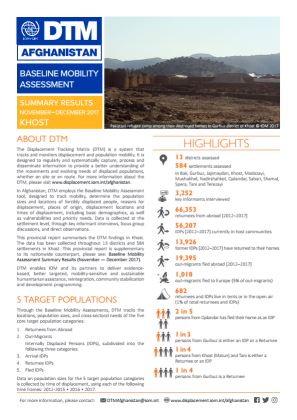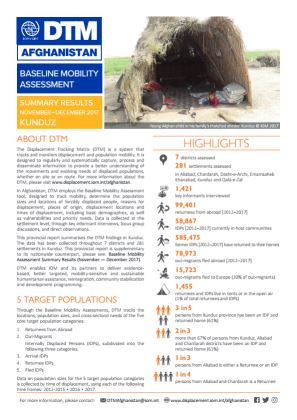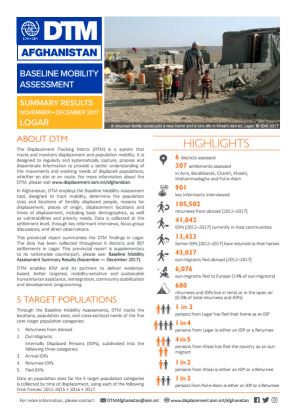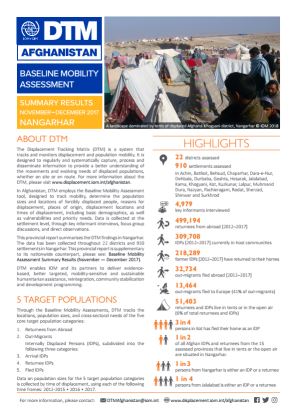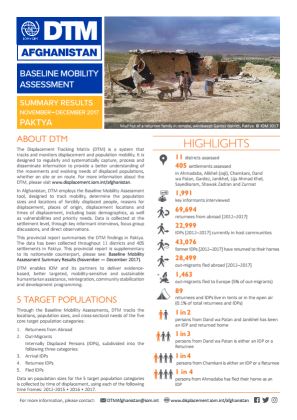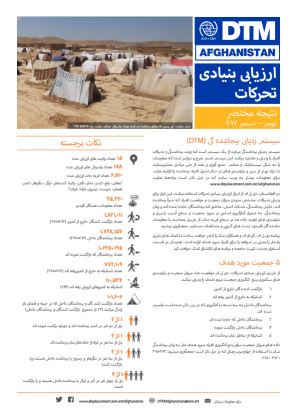-
Countries
-
Data and Analysis
-
Special Focus
-
Crisis Responses
Afghanistan
Afghanistan
Suivi des PDI
Mouvements de déplacement
4,187,000
IDMC 2023
cycle de collecte de données
À propos Afghanistan
The Displacement Tracking Matrix (DTM) is an information management system of tools and methodologies used to track and monitor displacement and population mobility. In Afghanistan, IOM activated the DTM programme in January 2017 in response to the substantial increase of Afghans returning home from neighbouring countries, as well as record levels of internal displacement. DTM in Afghanistan is designed to regularly and systematically capture, process and disseminate multi-layered information about the population sizes, locations, geographic distribution, movements, vulnerabilities, evolving multisectoral needs, and the drivers of migration of returnees, IDPs, migrants and mobile populations. DTM implements baseline mobility assessments, flow monitoring, registrations, and various migration surveys to provide an essential evidence base that enables decision-makers and humanitarian, reintegration and development partners to maximize resources and deliver efficient, better-targeted, mobility-sensitive and sustainable humanitarian; reintegration, community stabilization and development programming.
The value-added impact of DTM in Afghanistan is to inform action and results for people in need. DTM Afghanistan implements its activities at both the national and provincial levels. DTM works closely with other (IOM) programmes through referring identified populations in need of assistance at flow monitoring points to IOM’s Cross Border Return and Reintegration, Protection, Humanitarian Assistance, and Reintegration and Development (RADA) programmes. DTM Afghanistan also supports humanitarian partners and clusters, including WFP, FAO, UNHCR, IRC, DRC, NRC, and WHO, among many others, by providing emergency tracking updates in large-scale or sudden onset movements, such as emergency event tracking and drought response. Furthermore, stabilization and development actors, including IOM’s RADA programme, and the World Bank leverage DTM’s information to select priority communities and districts with higher concentrations of IDPs and returnees to receive reintegration and livelihoods assistance and improvements to core infrastructure and essential services. In support of health partners, including WHO, UNICEF, and the Humanitarian Health Cluster, DTM data informs the selection of priority, at-risk districts, border areas, communities, and health facilities in need of strengthened capacity, response, surveillance, and risk education for polio, TB, COVID-19, and other infectious diseases.
Contacter
Modher ALHAMADANI
Senior Programme Coordinator - DTM
malhamadani@iom.int
DTM AFGHANISTAN
DTMAFGHANISTAN@iom.int
Current Donors
- Republic of Korea
- Norway
- CERF
- Canada
- Italy
- EU
- FCDO
Afghanistan — Overview Maps — Total Inflows (IDPs and Returnees) (March 2018)
These two maps provide information on the total inflows of IDPs and Returnees in Afghanistan as of March 2018.
Afghanistan — Overview Maps — Baseline Mobility Assessments (March 2018)
The two maps provide information on IDPs and Returnees gathered during DTM's Baseline Mobility Assessment exercise conducted between January and March 2018.
Afghanistan — Overview Maps — Nomads (March 2018)
These three maps provide information about nomad familiaies and nomad individuals in Afghanistan as of March 2018.
Afghanistan — Overview Map — Returnees from Pakistan and Iran (March 2018)
These two maps provide information on the total number of Afghan returnees from Pakistan and Iran, as well as the number of Afghan returnees by status (documented or undocumented), as of March 2018.
Afghanistan — Overview Maps — Refugees (March 2018)
The two maps contained in this document provide information on refugee individuals and families in Afghanistan as of March 2018.
Afghanistan — Baseline Mobility Assessment Summary Results (January—March 2018)
In Afghanistan, DTM employs the Baseline Mobility Assessment tool, designed to track mobility, determine the population sizes and locations of forcibly displaced people, reasons for displacement, places of origin, displacement locations and times of displacement, including basic demographics, as
Afghanistan — Baghlan Baseline Mobility Assessment Summary Results (November — December 2017)
In Afghanistan, DTM employs the Baseline Mobility Assessment tool, designed to track mobility, determine the population sizes and locations of forcibly displaced people, reasons for displacement, places of origin, displacement locations and times of displacement, including basic demographics, as
Afghanistan — Balkh Baseline Mobility Assessment Summary Results (November — December 2017)
In Afghanistan, DTM employs the Baseline Mobility Assessment tool, designed to track mobility, determine the population sizes and locations of forcibly displaced people, reasons for displacement, places of origin, displacement locations and times of displacement, including basic demographics, as
Afghanistan — Farah Baseline Mobility Assessment Summary Results (November — December 2017)
In Afghanistan, DTM employs the Baseline Mobility Assessment tool, designed to track mobility, determine the population sizes and locations of forcibly displaced people, reasons for displacement, places of origin, displacement locations and times of displacement, including basic demographics, as
Afghanistan — Khost Baseline Mobility Assessment Summary Results (November — December 2017)
In Afghanistan, DTM employs the Baseline Mobility Assessment tool, designed to track mobility, determine the population sizes and locations of forcibly displaced people, reasons for displacement, places of origin, displacement locations and times of displacement, including basic demographics, as
Afghanistan — Kunar Baseline Mobility Assessment Summary Results (November — December 2017)
In Afghanistan, DTM employs the Baseline Mobility Assessment tool, designed to track mobility, determine the population sizes and locations of forcibly displaced people, reasons for displacement, places of origin, displacement locations and times of displacement, including basic demographics, as
Afghanistan — Kunduz Baseline Mobility Assessment Summary Results (November — December 2017)
In Afghanistan, DTM employs the Baseline Mobility Assessment tool, designed to track mobility, determine the population sizes and locations of forcibly displaced people, reasons for displacement, places of origin, displacement locations and times of displacement, including basic demographics, as
Afghanistan — Laghman Baseline Mobility Assessment Summary Results (November — December 2017)
In Afghanistan, DTM employs the Baseline Mobility Assessment tool, designed to track mobility, determine the population sizes and locations of forcibly displaced people, reasons for displacement, places of origin, displacement locations and times of displacement, including basic demographics, as
Afghanistan — Logar Baseline Mobility Assessment Summary Results (November — December 2017)
In Afghanistan, DTM employs the Baseline Mobility Assessment tool, designed to track mobility, determine the population sizes and locations of forcibly displaced people, reasons for displacement, places of origin, displacement locations and times of displacement, including basic demographics, as
Afghanistan — Nangarhar Baseline Mobility Assessment Summary Results (November — December 2017)
In Afghanistan, DTM employs the Baseline Mobility Assessment tool, designed to track mobility, determine the population sizes and locations of forcibly displaced people, reasons for displacement, places of origin, displacement locations and times of displacement, including basic demographics, as
Afghanistan — Nimroz Baseline Mobility Assessment Summary Results (November — December 2017)
In Afghanistan, DTM employs the Baseline Mobility Assessment tool, designed to track mobility, determine the population sizes and locations of forcibly displaced people, reasons for displacement, places of origin, displacement locations and times of displacement, including basic demographics, as
Afghanistan — Paktya Baseline Mobility Assessment Summary Results (November—December 2017)
In Afghanistan, DTM employs the Baseline Mobility Assessment tool, designed to track mobility, determine the population sizes and locations of forcibly displaced people, reasons for displacement, places of origin, displacement locations and times of displacement, including basic demographics, as
Afghanistan — Takhar Baseline Mobility Assessment Summary Results (November — December 2017)
In Afghanistan, DTM employs the Baseline Mobility Assessment tool, designed to track mobility, determine the population sizes and locations of forcibly displaced people, reasons for displacement, places of origin, displacement locations and times of displacement, including basic demographics, as
Afghanistan — Kabul Baseline Mobility Assessment Summary Results (November — December 2017)
In Afghanistan, DTM employs the Baseline Mobility Assessment tool, designed to track mobility, determine the population sizes and locations of forcibly displaced people, reasons for displacement, places of origin, displacement locations and times of displacement, including basic demographics, as
Afghanistan — Herat Baseline Mobility Assessment Summary Results (November — December 2017)
In Afghanistan, DTM employs the Baseline Mobility Assessment tool, designed to track mobility, determine the population sizes and locations of forcibly displaced people, reasons for displacement, places of origin, displacement locations and times of displacement, including basic demographics, as
Afghanistan — Kandahar Baseline Mobility Assessment Summary Results (November — December 2017)
In Afghanistan, DTM employs the Baseline Mobility Assessment tool, designed to track mobility, determine the population sizes and locations of forcibly displaced people, reasons for displacement, places of origin, displacement locations and times of displacement, including basic demographics, as
Afghanistan — Baseline Mobility Assessment Summary Results (November — December 2017)
In Afghanistan, DTM employs the Baseline Mobility Assessment tool, designed to track mobility, determine the population sizes and locations of forcibly displaced people, reasons for displacement, places of origin, displacement locations and times of displacement, including basic demographics, as
(افغانستان - نتیجه مختصر ارزیابی بنیادی تحرکات (نومبر - دسمبر 2017
در افغانستان، دی تی ام از ابزار ارزیابی تحرکات بنیادی استفاده میکند، این ابزار برای ردیابی تحرکات، مشخص نمودن میزان جمعیت و موقعیت افراد که جبرآ بیجاشده اند، دلایل بیجاشدگی، محلات اصلی، مناطق که بیجاشدگان جابجا شده اند و زمان بیجاشدگی، به شمول آمارگیری اساسی در مورد جمعیت و سطح آسیب پذیری و نیازم
Afghanistan — Returns to Afghanistan in 2017 (28 February 2018)
This report is a joint IOM-UNHCR report depicting Afghan returns from the neighbouring Islamic Republics of Iran and Pakistan and challenges faced by returning Afghans. Over 610,000 Afghans returned from the Islamic Republics of Iran and Pakistan in 2017.
Pagination
Pagination
Pagination
- First page
- Previous page
- 1
- 2
- 3
- 4
- 5











